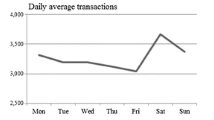Abstract
Service organizations that operate outside the normal 8-hour day and face wide fluctuations in demand constantly struggle to optimize the size and composition of their workforce. Recent research has shown that improved personnel scheduling methods that take demand uncertainty into account can lead to significant reductions in labor costs. This paper addresses a staff planning and scheduling problem that arises at United States Postal Service (USPS) mail processing & distribution centers (P&DCs) and develops a two-stage stochastic integer program with recourse for the analysis. In the first stage, before the demand is known, the number of full-time and part-time employees is determined for the permanent workforce. In the second stage, the demand is revealed and workers are assigned to specific shifts during the week. When necessary, overtime and casual labor are used to satisfy demand.
This paper consists of two parts: (1) the analysis of the demand distribution in light of historical data, and (2) the development and analysis of the stochastic integer programming model. Using weekly demand for a three-year period, we first investigate the possibility that there exists an end-of-month effect, i.e., the week at the end of month has larger volume than the other weeks. We show that the data fail to indicate that this is the case.
In the computational phase of the work, three scenarios are considered: high, medium, and low demand. The stochastic optimization problem that results is a large-scale integer program that embodies the full set of contractual agreements and labor rules governing the design of the workforce at a P&DC. The usefulness of the model is evaluated by solving a series of instances constructed from data provided by the Dallas facility. The results indicate that significant savings are likely when the recourse problem is used to help structure the workforce.
Similar content being viewed by others
References
Ahmed, S. (2004). Introduction to stochastic integer programming: an algorithmic perspective. Stochastic programming community home page. http://stoprog.org/recourses.html.
Aykin, T. (1996). Optimal shift scheduling with multiple break windows. Management Science, 42(4), 591–602.
Bard, J. F. (2004). Selecting the appropriate input data set when configuring a permanent workforce. Computers and Industrial Engineering, 47(4), 371–389.
Bard, J. F., Binici, C., & deSilva, A. H. (2003). Staff scheduling at the United States Postal Service. Computers and Operations Research, 30(5), 745–771.
Beaumont, N. (1997a). Scheduling staff using mixed integer programming. European Journal of Operational Research, 98(3), 473–484.
Beaumont, N. (1997b). Using mixed integer programming to design employee rosters. Journal of the Operational Research Society, 48(6), 585–590.
Bechtold, S. E., & Jacobs, L. W. (1990). Implicit modeling of flexible break assignments in optimal shift scheduling. Management Science, 36(11), 1339–1351.
Berman, O., Larson, R. C., & Pinker, E. (1997). Scheduling workforce and workflow in a high volume factory. Management Science, 43(2), 158–172.
Birge, J. R., & Dempster, M. A. H. (1996). Stochastic programming approaches to stochastic scheduling. Journal of Global Optimization, 9, 417–451.
Birge, J. R., & Louveaux, F. (1997). Introduction to stochastic programming. New York: Springer.
Brusco, M., & Jacobs, L. W. (1998). Personnel tour scheduling when starting time restrictions are present. Management Science, 44, 534–547.
Burns, R. N., & Carter, M. W. (1985). Work force size and single shift schedules with variable demands. Management Science, 31(5), 599–607.
Easton, F. F., & Rossin, D. F. (1997). Overtime schedules for full time service workers. Omega, 25(3), 285–299.
Emmons, H. (1985). Work-force scheduling with cyclic requirements and constraints on days off, weekends off, and work stretch. IIE Transactions, 17(1), 8–15.
Ernst, A. T., Jiang, H., Kishnamoorthy, M., & Sier, D. (2004). Staff scheduling and rostering: a review of applications, methods and models. European Journal of Operational Research, 153(1), 3–27.
Glazebrook, K. D. (1981). On nonpreemptive strategies in stochastic scheduling. Naval Research Logistics Quarterly, 28, 289–300.
Jarrah, A. I. Z., Bard, J. F., & deSilva, A. H. (1994). Solving large-scale tour scheduling problems. Management Science, 40(9), 1124–1145.
Kall, P., & Wallace, S. W. (1994). Stochastic programming. Chichester: Wiley.
Kao, E. P. C., & Queyranne, M. (1985). Budgeting costs of nursing in a hospital. Management Science, 31(5), 608–621.
Klein Haneveld, W. K., & van der Vlerk, M. H. (1999). Stochastic integer programming: general models and algorithms. Annals of Operations Research, 85(1), 39–57.
Louveaux, F., & Schultz, R. (2003). Stochastic integer programming. In A. Ruszczyński & A. Shapiro (Eds.), Handbooks in operations research and management science: Vol. 10: Stochastic programming. Amsterdam: Elsevier Science.
Mason, A. J., Ryan, D. M., & Panton, D. M. (1998). Integrated simulation, heuristic and optimisation approaches to staff scheduling. Operations Research, 46(2), 161–175.
McManus, I. M. (1977). Optimum use of overtime in post offices. Computers and Operations Research, 4(4), 271–278.
Morton, D. P., & Popova, E. (2003). A Bayesian stochastic programming approach to an employee scheduling problem. IIE Transactions on Operations Engineering, 36(2), 155–167.
Pinedo, M. L. (1983). Stochastic scheduling with release dates and due dates. Operations Research, 31(3), 559–572.
Prékopa, A. (1995). Stochastic programming. Dordrecht: Kluwer Academic.
Sen, S. (2003). Algorithms for stochastic mixed-integer programming models. Technical report, MORE Institute, SIE Department, University of Arizona, Tucson, AZ. http://tucson.sie.arizona.edu/MORE/papers/SIPHbook.pdf.
Shanthikumar, J. G., & Yao, D. D. (1992). Multiclass queueing systems: Polymatroid structure and optimal scheduling and control. Operations Research, 40(2), 293–299.
Showalter, M. J., Krajewski, L. J., & Ritzman, L. P. (1977). Manpower allocation in US postal facilities: a heuristic approach. Computers and Operations Research, 4(4), 257–269.
Zhang, X., & Bard, J. F. (2003). Equipment scheduling at mail processing and distribution centers. IIE Transactions on Scheduling and Logistics, 37(2), 175–187.
Author information
Authors and Affiliations
Corresponding author
Additional information
This work was supported in part by the National Science Foundation under grants DMI-0218701 and DMI-0217927.
Rights and permissions
About this article
Cite this article
Bard, J.F., Morton, D.P. & Wang, Y.M. Workforce planning at USPS mail processing and distribution centers using stochastic optimization. Ann Oper Res 155, 51–78 (2007). https://doi.org/10.1007/s10479-007-0213-1
Published:
Issue Date:
DOI: https://doi.org/10.1007/s10479-007-0213-1




